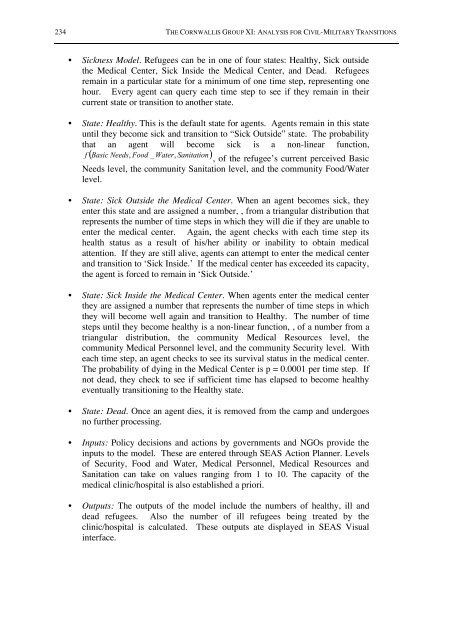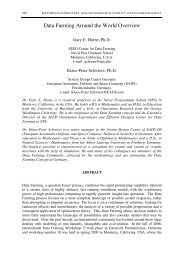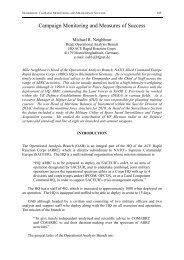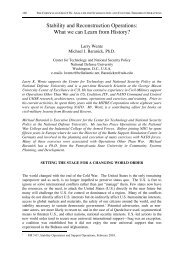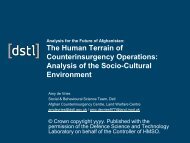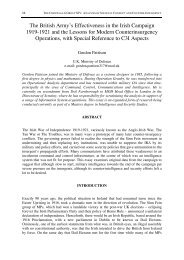Modeling Stability and Reconstruction Operation ... - Cornwallis Group
Modeling Stability and Reconstruction Operation ... - Cornwallis Group
Modeling Stability and Reconstruction Operation ... - Cornwallis Group
Create successful ePaper yourself
Turn your PDF publications into a flip-book with our unique Google optimized e-Paper software.
234 THE CORNWALLIS GROUP XI: ANALYSIS FOR CIVIL-MILITARY TRANSITIONS• Sickness Model. Refugees can be in one of four states: Healthy, Sick outsidethe Medical Center, Sick Inside the Medical Center, <strong>and</strong> Dead. Refugeesremain in a particular state for a minimum of one time step, representing onehour. Every agent can query each time step to see if they remain in theircurrent state or transition to another state.• State: Healthy. This is the default state for agents. Agents remain in this stateuntil they become sick <strong>and</strong> transition to “Sick Outside” state. The probabilitythat an agent will become sick is a non-linear function,f ( Basic Needs,Food _ Water,Sanitation), of the refugee’s current perceived BasicNeeds level, the community Sanitation level, <strong>and</strong> the community Food/Waterlevel.• State: Sick Outside the Medical Center. When an agent becomes sick, theyenter this state <strong>and</strong> are assigned a number, , from a triangular distribution thatrepresents the number of time steps in which they will die if they are unable toenter the medical center. Again, the agent checks with each time step itshealth status as a result of his/her ability or inability to obtain medicalattention. If they are still alive, agents can attempt to enter the medical center<strong>and</strong> transition to ‘Sick Inside.’ If the medical center has exceeded its capacity,the agent is forced to remain in ‘Sick Outside.’• State: Sick Inside the Medical Center. When agents enter the medical centerthey are assigned a number that represents the number of time steps in whichthey will become well again <strong>and</strong> transition to Healthy. The number of timesteps until they become healthy is a non-linear function, , of a number from atriangular distribution, the community Medical Resources level, thecommunity Medical Personnel level, <strong>and</strong> the community Security level. Witheach time step, an agent checks to see its survival status in the medical center.The probability of dying in the Medical Center is p = 0.0001 per time step. Ifnot dead, they check to see if sufficient time has elapsed to become healthyeventually transitioning to the Healthy state.• State: Dead. Once an agent dies, it is removed from the camp <strong>and</strong> undergoesno further processing.• Inputs: Policy decisions <strong>and</strong> actions by governments <strong>and</strong> NGOs provide theinputs to the model. These are entered through SEAS Action Planner. Levelsof Security, Food <strong>and</strong> Water, Medical Personnel, Medical Resources <strong>and</strong>Sanitation can take on values ranging from 1 to 10. The capacity of themedical clinic/hospital is also established a priori.• Outputs: The outputs of the model include the numbers of healthy, ill <strong>and</strong>dead refugees. Also the number of ill refugees being treated by theclinic/hospital is calculated. These outputs ate displayed in SEAS Visualinterface.


